An international group exhibition which deals with the invisible economies linked to the sea. In their works, world-respected artists deal with unusual and radical phenomena, from strange online shops to the empires of amateur pornography and other golden coasts.
In the geographical sense, Europe is a maritime continent, and the sea has always fundamentally shaped its entire development: considering the ratio of the length of the coast to the total land surface, Europe has more contact with the sea than any other continent. For Rijeka, the port, as well as the sea, is not only a place of the loading and unloading or the arrivals and departures of boats. The port is the heart of the city and symbolically important for the identity of the city. This is why the sea, and new forms of work and economy which are connected to the sea, are extremely important for both Rijeka and Europe.
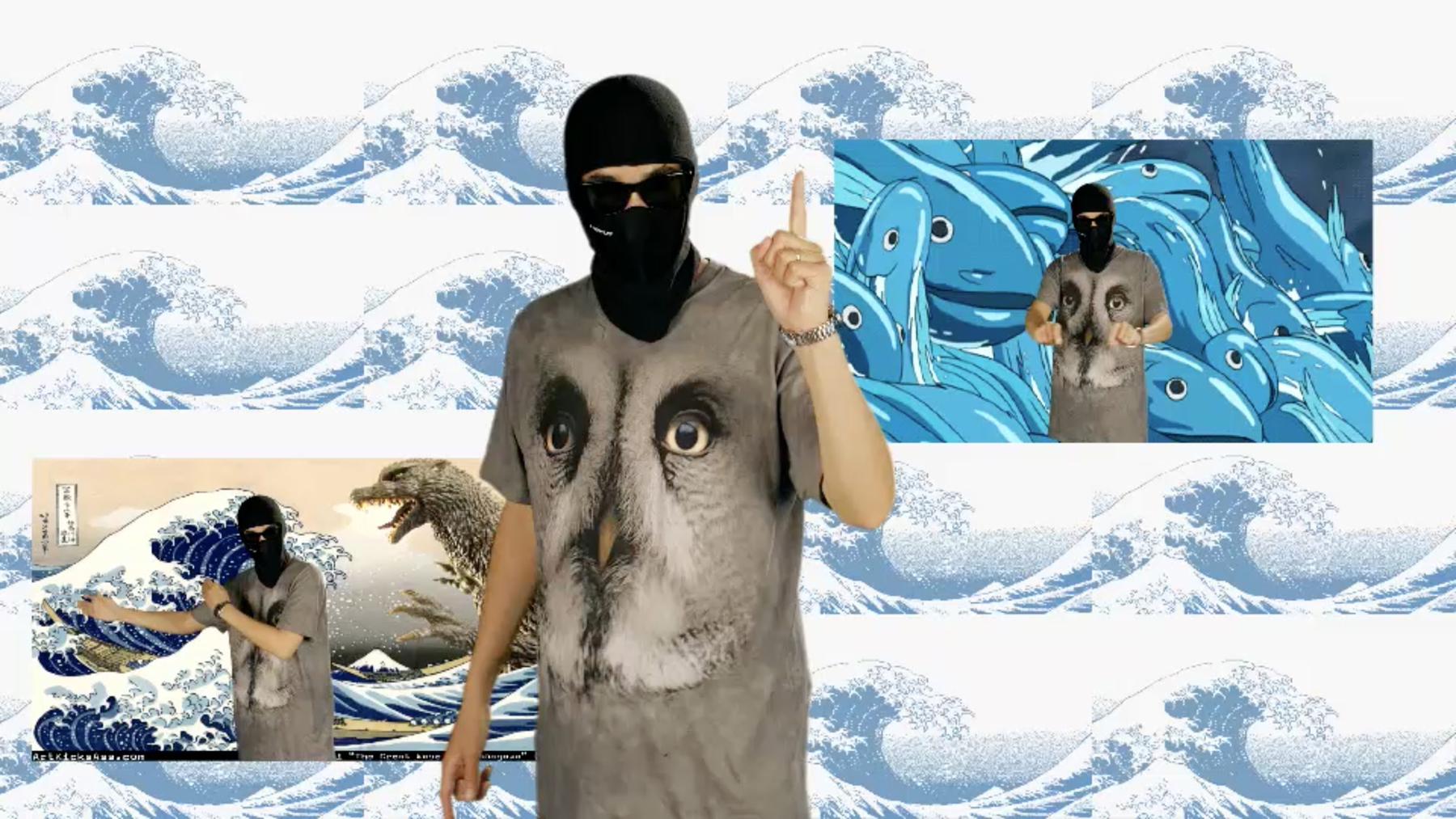
The exhibition The Sea Is Glowing looks at new invisible economies connected to the sea – in the ocean, like deep sea mining, at the sea shore, like offshore tax havens, and on the sea, like ultra-libertarian sea-steading start-ups. All of these activities are part of new economies that involve new kinds of labour, like outsourced micro-work, global logistics, or new kinds of capital circulation, happening in places like freeports. Harbour cities like Rijeka are of particular interest for these kinds of economies because of their (at times) special taxation model. In addition, the deep sea is a ‘new frontier’ in the quest for resources. The artists in the exhibition The Sea Is Glowing look at weird Amazon shops, externalized data-cleaning work, deep sea mining, rising sea levels, hidden offshore paradises, empires of amateur pornography and other lucrative shores. In short: A sea of labour.
The exhibition is curated by Inke Arns (DE), PhD, who is famous for her work in media art. She is the director of the Dortmund Hartware MedienKunstVerein (HMKV) organisation and the curator of numerous international exhibitions that have been shown around Europe and the world – from Berlin, Glasgow and Warsaw, from Ljubljana and Nova Sad, all the way to Moscow, Tel Aviv and Hong Kong.
The exhibition presents the works of 15 European and global artists and groups: Aram Bartholl (DE), Ursula Biemann (CH), DISNOVATION.ORG (FR/PL), Jacob Hurwitz-Goodman / Daniel Keller (US), Steffen Köhn (DE), Lawrence Lek (GB), Rebecca Moss (GB), Jenny Odell (US), Elisa Giardina Papa (IT), Lisa Rave (DE), Marie Reinert (FR), Tabita Rezaire (GF), RYBN (FR), Sebastian Schmieg (DE), and Hito Steyerl (DE).
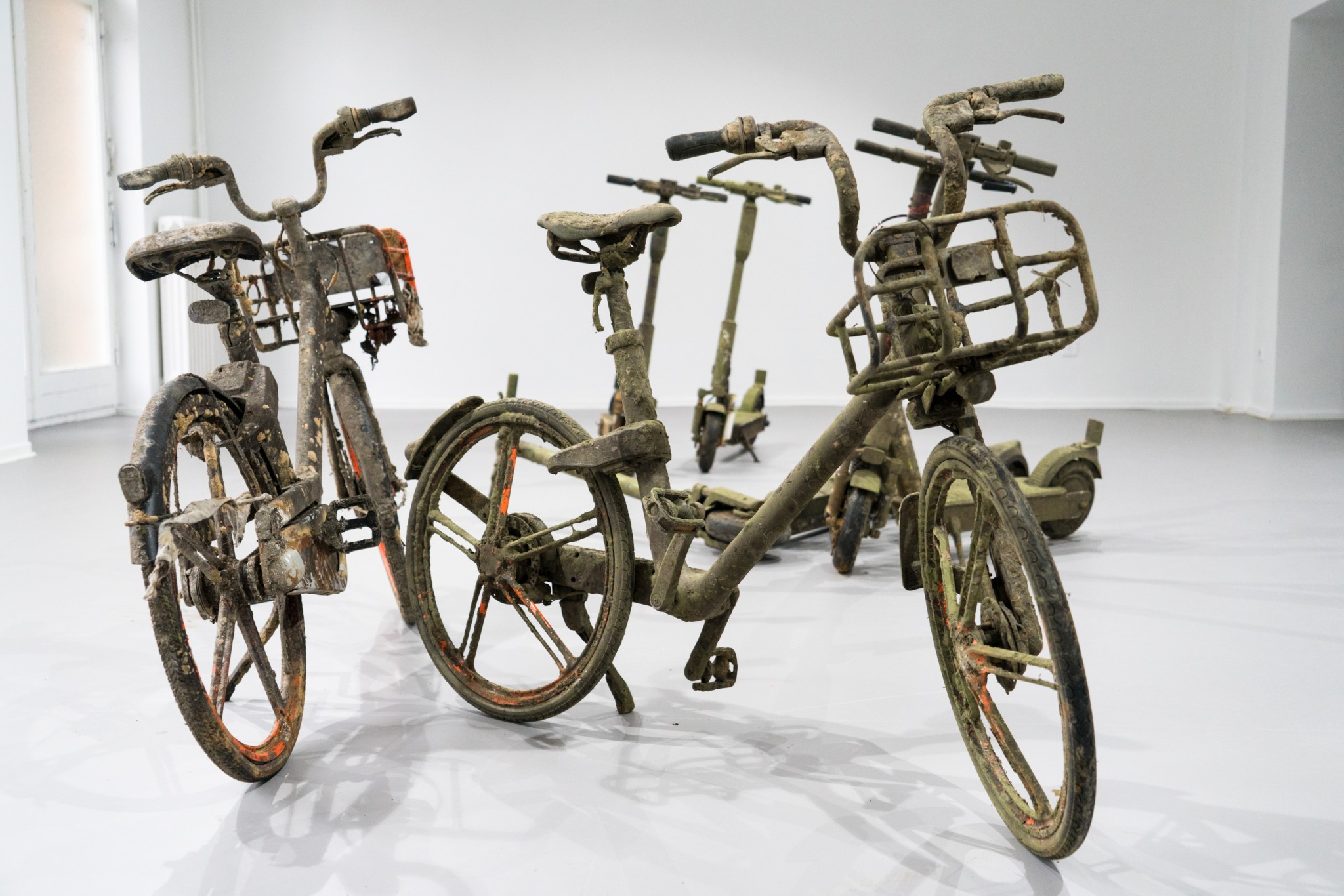
Aram Bartholl: Unlock Life
Installation, rental e-scooters, rental bikes, variable, 2020
For his installation Unlock Life, Aram Bartholl retrieved a number of rental e-scooters and bikes from different canals of Berlin. Globally operating start-ups have swamped all major European cities with rental bikes and e-scooters in large numbers and in fierce competition with each other in the last couple of years. The careless attitude of the start-up companies has resulted in disapprovement by most of the public and careless handling by users. The colourful pop aesthetics of these rides attract the urban youth who cannot afford to ride them. Destruction and loss is a calculated part of the business which is economically and ecologically unsustainable. Also, these e-scooters and bikes often getthrown into the canals of the city. After spending months or even years in the water, the scooters have completely lost their allure and are covered with mud and algae. Once pulled out of the water, new life can be found on these scooters in the form of small crabs and worms. Unlock Lifeis the signature advertising slogan of the e-scooter company Lime. (Aram Bartholl)
Aram Bartholl uses sculptural interventions, installations, and performative workshops to question our engagement with media and with public economies linked to social networks, online platforms, and digital dissemination strategies. He addresses socially relevant topics, including surveillance, data privacy and technology dependence, through his work by transferring the gaps, contradictions, and absurdities of our everyday digital lives to physical settings.
Ursula Biemann: Deep Weather
Single channel video projection, 2013, 9:00 min.
Deep Weather (2013) is a nine-minute glimpse of the Alberta tar sands in Canada, juxtaposed with the watery world of Bangladesh. The whispered, confiding voice-over makes us feel immediately complicit in the actions unfolding here. While human actions are paramount in what happens to the Earth in this Anthropocene era, we have little awareness of, or control over, fluid and invisible global interactions. The vast open-pit mines and steam processing of the oil-infused sand and clay of northern Alberta have drastically lowered the Athabasca River’s flow to the Arctic Ocean; poisoned tailing ponds are replacing the boreal forests, altering ecology for an unknown future. Land is reduced to a commodity by multinational corporations with little concern for the planet’s future well-being. In Bangladesh, rising sea levels – a result of melting Himalayan ice – are claiming inhabitable land, impacting large populations with nowhere else to go. Communities respond by sandbagging mud embankments and devising floating agriculture and convertible schools: manual efforts on a heroic scale against nearly impossible odds. (source: Musée d’art contemporain de Montréal)
Ursula Biemann is an artist, writer and video essayist based in Zurich. Her artistic practice is strongly research oriented and involves fieldwork in remote locations where she investigates the political ecologies of forests, oil and water. Her video installations are exhibited at the International Art Biennials of Istanbul, Liverpool, Sao Paulo, Taipei, Shanghai, Gwangiu, Montreal, and in museums worldwide. In 2020 she has a solo exhibition at the Museum for Modern Art in Nice. Biemann received the 2009 Swiss Grand Award Meret Oppenheim.
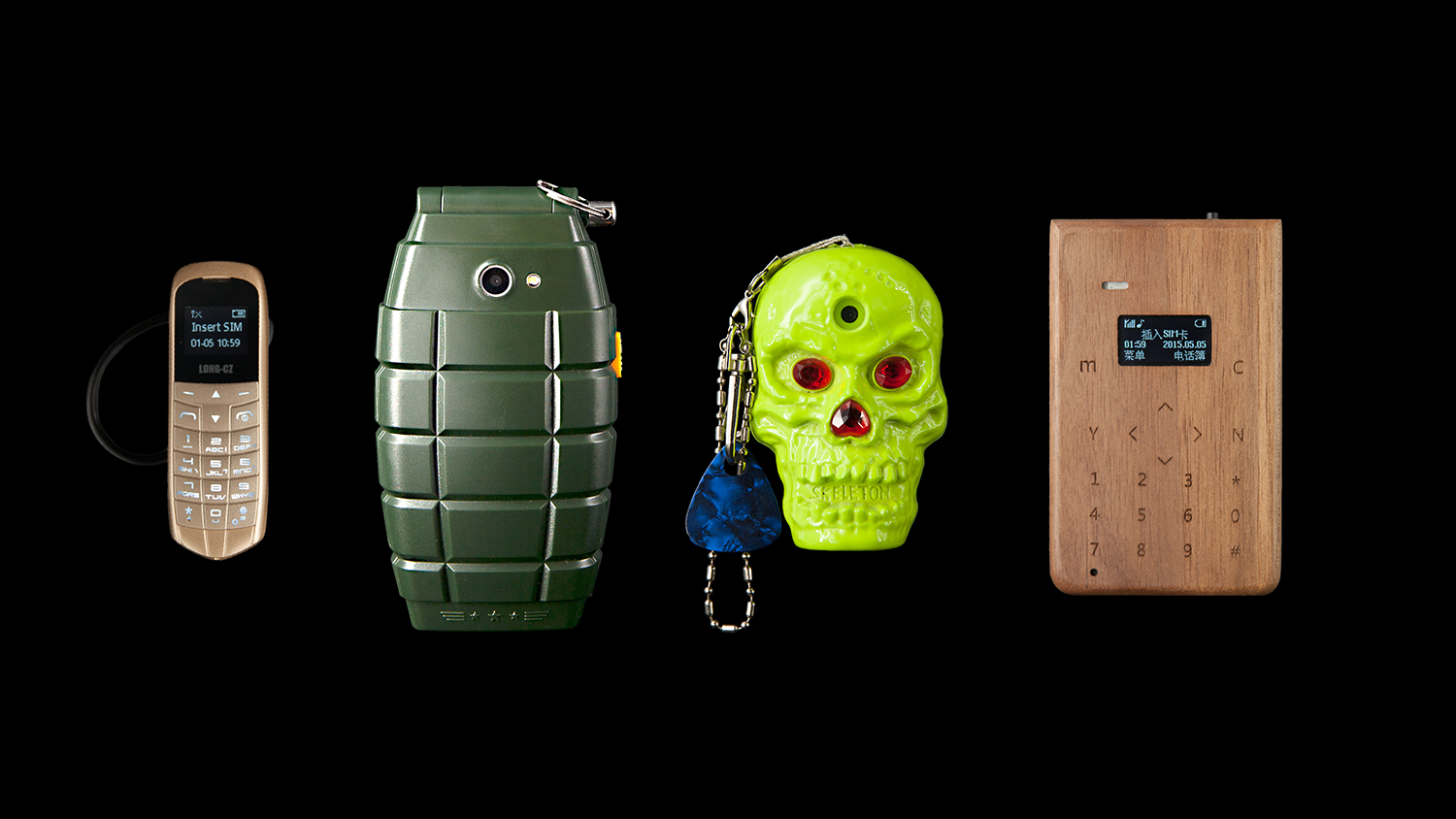
DISNOVATION.ORG: Shanzhai Archaeology
Installation, collection, research, 2 videos, 2015-2018
Conception: DISNOVATION.ORG, Clément Renaud & Yuan Qu; 3D Models: Terrell Davis
The Chinese term shanzhai (山寨) refers to counterfeit consumer goods. This includes imitation, trademark infringement, parody, lookalikes and improved goods, particularly in the field of electronics. Shanzhai Archeology presents an extraordinary collection of mobile phones from this “Made in China” technological interbreeding. These are hybrid products developed at an incredible speed merging piracy, reverse engineering, unique creativity and self-taught skills. While the small companies specializing primarily in making and assembling toys, clothes and electronics are a profitable business, the working conditions in these shanzhai factories located in the mountains of the Shenzhen Special Economic Zone (SEZ) are harsh, often making a job at Foxconn a desirable achievement. Shanzhai mainly happens out of Western sight, due to regulations that forbid most of these hybrid products to circulate legally across borders. Nevertheless, shanzhai devices fulfil a bespoke need or desire for hundreds of thousands of consumers in countries around the world, not just in China. Shanzhai represents singular design solutions outside streamlined market forces and global innovation myths. (Irini Papadimitriou / Inke Arns)
DISNOVATION.ORG is an artist led action-research collective founded in 2012 in Paris. They develop interdisciplinary inquiries and practices involving artists, anthropologists, philosophers, activists, engineers, architects, designers and hobbyists. At the crossroads between contemporary art, research and hacking, the collective creates situations of debate, speculation and disturbance, that challenge dominant ideologies such as techno-solutionism and infinite growth, and foster post-growth imaginaries and practices. Their research includes artworks, curation and publications. In 2015, they edited The Pirate Book, an anthology on media piracy. In 2018 they received a Design Trust Grant for research on China’s copycat and grassroots innovation culture (shanzhai). In 2019, they were visiting researchers at the University of California, Irvine for research on post-growth and eco-politics.
Jacob Hurwitz-Goodman / Daniel Keller: The Seasteaders
Single-channel video, 2018, 28:36 min.
Courtesy of DIS.ART
In 2008, Peter Thiel, a billionaire investor and Trump transition team member, launched a mission to develop a floating city, called a seastead, that would operate independently from existing nations. He imagined “an escape from politics in all its forms” in a new ultra-libertarian society. The PayPal co-founder partnered with Patri Friedman, a Google software engineer, to launch the Seasteading Institute. Based in Silicon Valley, its goal was to build a permanent and politically autonomous settlement off the coast of the South Pacific islands. Located an eight-hour flight from Los Angeles, French Polynesia was to become the host nation. It has a fibre cable that runs underwater to Hawaii, providing the bandwidth that tech workers would require. Rising sea levels threaten French Polynesia’s existence, which made a proposal to build new land appealing to the government. As the Seasteading Institute plotted its vision, the locals from Tahiti grew increasingly concerned about the prospect of “tech colonialism.” In 2017, Jacob Hurwitz-Goodman and Daniel Keller followed the Seasteading Institute leadership at a conference in Tahiti. Just before the release of the video on DIS.ART, the Seasteading Institute released its own (favourably) edited version of the video footage online. (Inke Arns)
Jacob Hurwitz-Goodman is a Los Angeles-based director originally from Detroit. His intimate, provocative documentary work has won a regional EMMY and an Edes Award for Emerging Artists. His films have been featured in the Zeppelin Museum, the BBC, the Athens Biennale, the DeYoung Museum, PBS, Atlas Obscura, the Washington Post, NBC Left Field, and a handful of other platforms. This work has brought him to Ghana, Burkina Faso, Vietnam, Tahiti, a heavy metal cruise ship in the Caribbean, and a snake-handling Pentecostal Church in Kentucky. He has directed music videos for Squarepusher (Warp Records), DNTEL (Dublab), Anna Ash, Gosh Pith, and Horatio Clam.
Daniel Keller is an American artist and writer based in Berlin. He is a contributor to Rhizome, Texte Zur Kunst, Frieze, DIS and Spike Art. His work has been exhibited at The New Museum, NYC; Musée d’Art Moderne de la Ville de Paris; Kunsthalle Wien, Vienna; Museum of Modern Art in Warsaw; Fridericianum, Kassel; The Athens Biennale; KW, Berlin. He is co-host of the New Models Podcast.
Steffen Köhn: Always Here
Video, 2015, 11:24 min.
On various websites, actors perform sexual acts for money. Many of these “models” are from Eastern Europe, and work in shifts of eight to ten hours; a substantial portion of their lives is therefore spent in front of cameras that stream their every action and word to the internet. While waiting for clients, their time is spent making small talk, dozing, surfing the net or discussing dinner plans. The ordinariness of daily life runs in stark contrast to the character of their work. As with all platform capitalism companies, intermediaries are co-profiteers of all income generated through their website. (Tilman Baumgärtel)
Steffen Köhn obtained an M.A. in social anthropology and film studies before studying film directing at the German Film- and Television Academy Berlin (dffb). He works in both documentary and fiction and further creates more experimental video art pieces that he shows internationally in galleries and museums. In 2014 he completed a PhD in visual and media anthropology. The practical part of this project, a two-channel video installation A TALE OF TWO ISLANDS was screened in Berlinale’s Forum Expanded section in 2012. AFTER HOURS (2013), his architectural portrait of the infamous techno club Berghain was part of the exhibition Kultur:Stadt at Berlin’s Academy of the Arts and the Kunsthaus Graz. His first cinematic feature SMILE (2019), a co-production with ZDF – Das kleine Fernsehspiel, premiered at the Galway Film Fleadh.
Lawrence Lek: Sinofuturism (1839 – 2046 AD)
HD video essay, 3-channel video installation, 2016/2020, 60:00 min.
Sinfofuturizam is an invisible movement. A spectre already embedded into a trillion industrial products, a billion individuals and a million veiled narratives. It is a movement, not based on individuals, but on multiple overlapping flows. Flows of populations, of products and of processes. Because Sinofuturism has arisen without conscious intention or authorship, it is often mistaken for contemporary China. But it is not. It is a science fiction that already exists. Sinofuturism is a video essay combining elements of science fiction, documentary melodrama, social realism and Chinese cosmologies, in order to critique the present-day dilemmas of China and the people of its diaspora. With reference to Afrofuturism and Gulf Futurism, Sinofuturism presents a critical and playful approach to subverting cultural clichés. In Western media and Orientalist perceptions, China is exotic, strange, bizarre, kitsch, tacky, or cheap. In its domestic media, China portrayed as heroic, stable, historic, grand and unified. Rather than counteract these skewed narratives, Sinofuturism proposes to push them much further. By embracing seven key stereotypes of Chinese society (Computing, Copying, Gaming, Studying, Addiction, Labour and Gambling), it shows how China’s technological development can be seen as a form of Artificial Intelligence. This installation includes two new video loops which explore the manifestation of Sinofuturism through recent developments in the ‘5G’ and ‘Belt and Road’ initiatives. (Lawrence Lek)
Lawrence Lek is an artist and filmmaker working in the fields of virtual reality and simulation. He creates site-specific virtual worlds and speculative films using game software, 3D animation, installation and performance. By rendering real places within fictional scenarios, his architectural environments reflect the impact of the virtual world on our perception of reality.
Marie Reinert: I see
7 interviews, 7 sound files, 7 vinyl records, 7 record players, 2020
Sound: Nicolas Mallet; Loop system: Guillaume Stagnaro
Marie Reinert is an artist who likes to take risks. She is interested in “infiltrating” the city’s fabric and in making explorations into an unknown, local terrain. Prior to the exhibition, she came to Rijeka where she conducted interviews about the future with people of different ages, professions, backgrounds, political positions and genders. She asked them to tell her about the future in the first person singular: “I see …”. These are not glitzy high-tech science fiction stories, but rather visions of a future gathered as if under hypnosis or while sleepwalking. Via audio recordings pressed on vinyl records we can listen to seven individual imaginaries and join each individual’s speculative dérive. The interviews were conducted in a language unknown to the artist. The recordings pressed on analogue vinyl records display digital artefacts, which are reminiscent of technical bugs the artist encountered during lockdown. Each composition is fading into future favourite songs proposed by each participant. (Inke Arns)
Marie Reinert’s practice consists of performances and installations including video, sound, drawings and texts. Her work explores and analyses the processes of normalization of our behaviours – particularly in the world of work. The body has emerged as the core element of her research: through strategies of infiltration, observation and archiving, she examines the systems, codes and protocols that condition the movements of bodies in their spatial and social environment. Her research is conducted in the form of residencies and collaborations: at the Public Archives (video Faire, Valeurs croisées – Biennale d’art contemporain de Rennes, 2008), on a merchant ship between Marseille and Algiers (video Roll On Roll Off, Marseille, 2011), at the oil and gas port of Fos sur mer (video “Quai” 2014), and at the Dutch National Bank in Amsterdam (video “Bull & Bear” 2014), in Kinshasa “Article 15” 2016 / 1017, in Biennale de Lyon (2019).
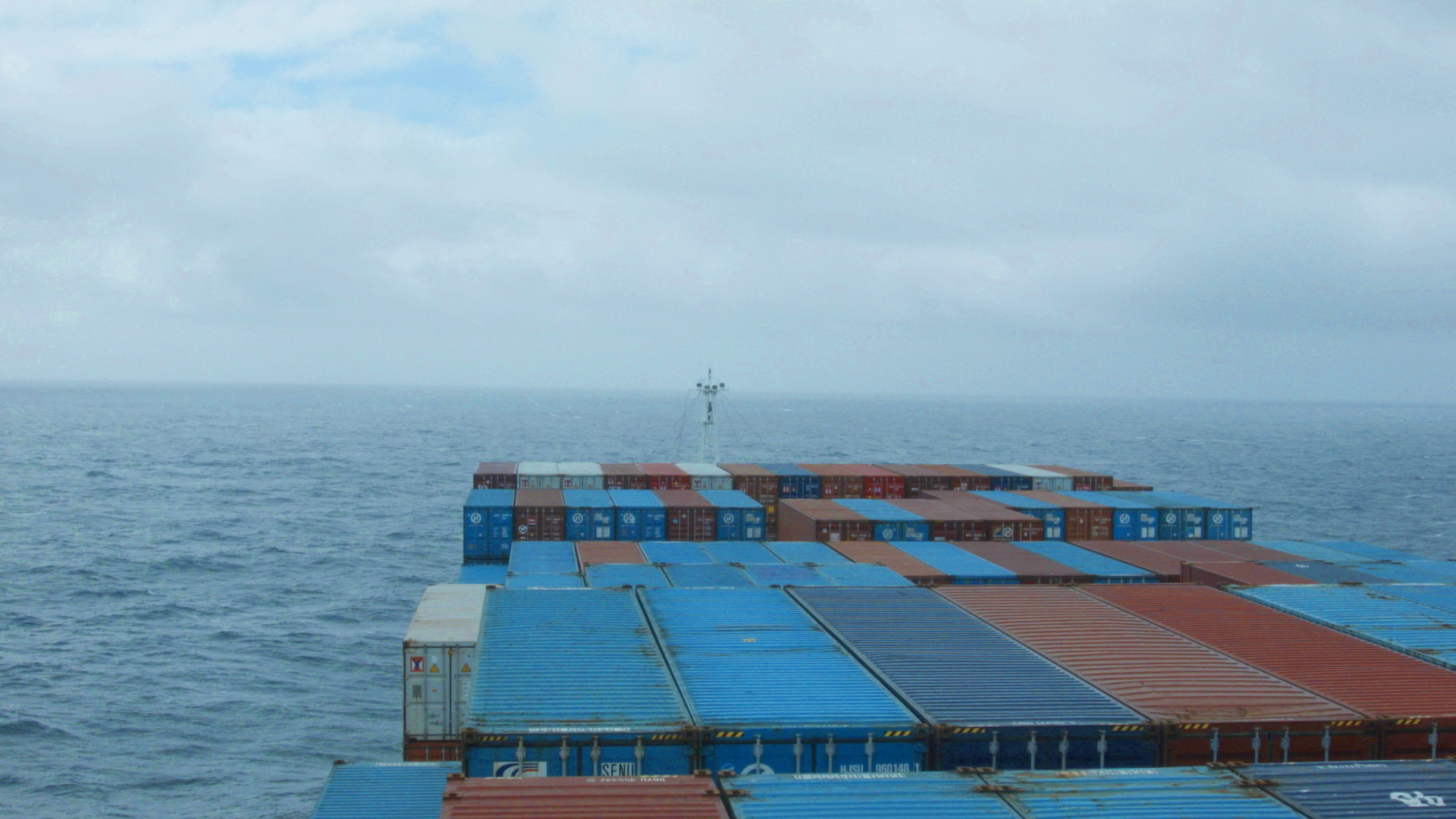
Rebecca Moss: International Waters
Video, 2017, 20:00 min.
In September 2016, Rebecca Moss found herself in a bizarre situation: she was one of 25 people stranded amid thousands of shipping containers on a 65,000-tonne ship sitting off the coast of Japan with no destination. The ship was one of dozens of vessels idling in international waters after Hanjin Shipping Co., the world’s seventh-largest container shipper, filed for bankruptcy in late August 2016. The Hanjin Geneva, laden with goods that range from animal skins to frozen french fries, left Vancouver in August en route to Shanghai. Moss embarked on the ship as part of an artist residency – titled “23 Days at Sea” – organised by Vancouver’s Access Gallery. The collapse of the Seoul-based company left an estimated 2,500 sailors, most of them from South Korea, the Philippines and Indonesia, stranded at sea alongside $14bn worth of goods. With its assets frozen, ships were refused permission to offload or take aboard containers because there were no guarantees that tugboat pilots or stevedores would be paid. The Hanjin Geneva anchored 12 km from the coast of Tokyo and waited for over two weeks for further instruction, rendering the captain and crew powerless to make decisions. (Inke Arns)
Rebecca Moss is an artist based in the UK. She completed her MA in Sculpture at the Royal College of Art in 2017. Writing for the Future Generation Art Prize, 2017, the curator Anna Smolak described: ‘Rebecca Moss is interested in moments of disruption, chaos and failure (…) her gestures subversively set the ridiculous and banal against the monumental and sublime.” Moss’ work critically examines heroic narratives, by exploring the potential of slapstick and absurdist comedy from a feminist perspective. Her work takes a variety of forms across moving image, performance and sculpture. Moss gained international attention when she undertook an art residency on a container ship across the Pacific Ocean, but discovered a week into the voyage that the company Hanjin Shipping had gone bankrupt. This meant that she became stuck on a container ship for three weeks off the coast of Japan, unable to pay to enter any ports worldwide. She subsequently made a video documenting this time, which premiered during the 57th Venice Biennale. Solo shows include: Staging Series, Jerwood Visual Arts, London (2019), From the Sublime to the Ridiculous, Bunkier Sztuki, Krakow (2019). Group shows include: TBCTV, Somerset House, London, UK (Frieze Week 2019) Future Generation Art Prize, PinchukArtCentre, Kiev & Venice (2017), A BROKEN LINK, Golden Age Cinema, Sydney Australia (2017), 23 Days at Sea, container ship residency and exhibition, Access Gallery, Vancouver (2016), Test Space, Spike Island, Bristol, UK (2015) and Leverhulme Scholarship Summer School Residency and exhibition, Wysing Arts Centre, Cambridge, UK (2014)
Jenny Odell: A Business With No End
Interactive web project, 2018
Uncanny e-commerce is Jenny Odell‘s passion. Some years ago, she noticed a strange empire of Amazon shops bearing baffling and surreal names like Bropastures, Dreamlish and Your Friend Bart LLC (Limited Liability Company). Each of these companies was associated with an Amazon seller with an equally bizarre but unrelated name, like Ipple Store, DeepOceanStoreuk and GiGling EyE. There was little pattern or theme to what these Amazon shops sold. They had everything from hemorrhoid cream to desk lamps, from books on industrial electricity and children’s dinosaur costumes to sets of fake facial wounds and a canister of butane fuel. One thing these LLCs had in common, though, was that they were strangely expensive – and that their registered agent was named Jonathan Park. Also, a handful of the listed agents were alumni of Olivet University, a Bible college which was established in California in 2000 by an evangelical pastor named David Jang. His global religious community has been the subject of numerous articles that allege labour violations, fraud and abuse. In this interactive web project published on 27 November 2018 on the New York Times website, the artist takes us on a surreal trip deep into the internet rabbit hole. (Inke Arns)
Jenny Odell is an artist and writer whose work often interrogates details of the everyday. Odell teaches studio art at Stanford University and has been an artist in residence at the Internet Archive, the New York Public Library, the San Francisco Planning Department, at Recology SF (otherwise known as the dump). She is the author of How to Do Nothing: Resisting the Attention Economy (Melville House, 2019).
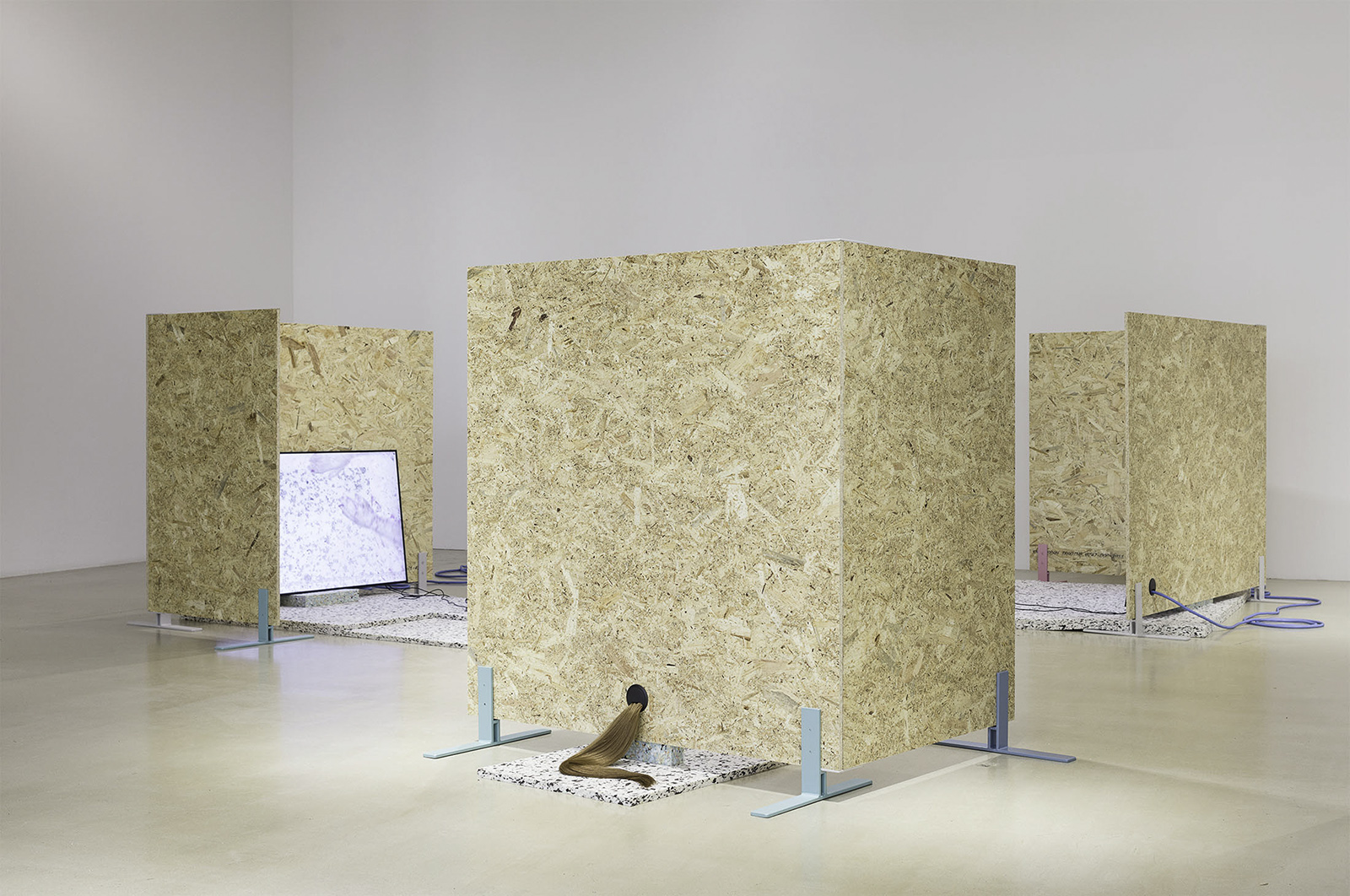
Elisa Giardina Papa: Technologies of Care
Video installation, 2016, 24:47 min.
Elisa Giardina Papa portrays workers who offer digital micro-services, fetish work or emotional support online, and converses with them about their work. In Technologies of Care, we meet seven digital workers: an ASMR (Autonomous Sensory Meridian Response) artist, a virtual boyfriend, an online dating coach, a storyteller and video performer, a social media fan, a scientist working simultaneously as a fingernail designer, and a customer service representative. Papa contacted these freelancers in Brazil, Greece, the Philippines, Venezuela and the USA, where they offer their services anonymously via online platforms, which make a profit from them. With the exception of the virtual boyfriend, all interviews are interpreted by female-sounding voices. While the transcripts read like ethnographic research texts, the interviews in the video function like chamber plays on unfettered digital neoliberalism. (Inke Arns)
Elisa Giardina Papa is an Italian artist whose work investigates gender, sexuality, and labor in relation to neoliberal capitalism and the Global South. In her recent body of work she documents the ways in which affective and care labor are being outsourced via internet platforms. In her current project she extends this exploration to the invisible and underpaid labor of data cleaning that sustains artificial intelligence (A.I.). Her work has been exhibited and screened at MoMA (New York), Whitney Museum [Sunrise/Sunset Commission], Seoul Mediacity Biennale 2018, Institute for Contemporary Art, Milano (ICA Milano), among others.
Lisa Rave: Europium
HD video, 2014, 20:00 min.
Europium is a rare earth element that is named after the European continent. Because of its ability to phosphoresce in a colour tone that cannot be synthesised by technical means, Europium is a key element in colour screens and played a decisive role in the revolution in colour television from the 1960s onwards. Using various levels of imagery, the essay film Europium draws connections between Papua New Guinea’s colonial past and the planned excavation of raw materials from the Bismarck Sea. Europium will be culled from the ocean floor to ensure brilliant colour images on smartphone displays, tablets, laptops and other flat screens, and of course for its fluorescent property, which is used to guarantee the authenticity of Euro banknotes. It plays a subordinate role that the seabed is an important component of the planetary ecosystem and that the extraction will also destroy the livelihoods of the indigenous population. The video invites the viewer on a journey that begins in the glossy brochure of a leading global display manufacturer and leads back in time to the colonial history of “German New Guinea.” (Inke Arns)
Lisa Rave (UK/Germany) is based in Berlin. She studied experimental film at the University of the Arts Berlin, as well as photography at Bard College, New York. She currently teaches at the Academy of Fine Arts Nuremberg. Her most recent exhibitions include; Circular Flow – On the Global Economy of Inequality Kunstmuseum Basel, Symptom Bauhaus West Den Haag, The Drowned World Toronto Biennale.
Tabita Rezaire: Deep Down Tidal
HD video, 2017, 18:44 min.
Courtesy of the artist and Goodman Gallery
The seas are full of secret stories – from fibre-optic cables and sunken cities to drowned bodies, forgotten expeditions and sacred signal transmissions. Oceans are complex communication networks. Deep Down Tidal explores the infrastructure of submarine fibre-optic cables through which our digital data travels. It is striking to note that the routing of these cables follows the old, colonial maritime trade routes. Colonialism aimed to create new trade routes and resulted in a strengthening of European powers thanks to the forceful extraction of mineral resources and slavery. Today we are witnessing the rise of electronic colonialism: while on the surface the World Wide Web connects us, digital inequality is growing due to the exploitation of our private data. Deep Down Tidalunderstands the ocean as a cemetery of Black knowledge and Black technologies. From Atlantis via the Middle Passage to the refugees drowning in their attempt to cross the Mediterranean, the sea encapsulates our pains, lost stories and memories while at the same time containing the global infrastructure of today’s telecommunication. (Inke Arns)
Tabita Rezaire is an artist-healer-seeker working with screens and energy streams. Her cross-dimensional practice envisions network sciences – organic, electronic and spiritual – as healing technologies to serve the shift towards heart consciousness. Navigating digital, corporeal and ancestral memory as sites of struggles, she digs into scientific imaginaries to tackle the pervasive matrix of coloniality that affect the songs of our body-mind-spirits. Tabita is based in Cayenne, French Guyana.
RYBN: The Great Offshore
Installation, chart, wallpaper, several showcases, tables, chairs, computer workstations, video player, MP3 player, headphones, 2019/2020
The Great Offshore is a documentary artwork that invites us on a journey into the depth of the offshore industry. The work gathers documents, narratives, photographs and objects collected during several trips to some of the most notorious tax havens: Dublin, London, Zürich and Pfäffikon, Switzerland, Vaduz, Liechtenstein, Jersey andGuernsey, Wilmington Delaware, the Bahamas, the Cayman Islands, Malta, Amsterdam, Luxembourg. In Rijeka, The Great Offshore pays attention to the most singular and uncanny incarnations of the offshore phenomenon: Art freeports, Luxembourg‘s futuristic space mining projects, Malta’s golden passport programs, experimental seasteading projects. All these contemporary manifestations of the offshore regime have in common that they are based on the legal framework that rules the oceans (freeports, deep-sea mining, flags of convenience, international waters). Connected together in a speculative trans-historical narrative, they document the emergence of a new regime of liquid governance. (RYBN / Inke Arns)
RYBN: Offshore Tour Operator
GPS prototype, 2019/2020
Offshore Tour Operator is a situationist GPS prototype, orientated toward a computer assisted psychogeographic drift that dictates the walk of the user through the International Consortium of Investigative Journalists (ICIJ) Offshore Leaks database addresses – including the Offshore Leaks, the Bahamas Leaks, the Panama Papers, the Paradise Papers. The Panama Papers, for example, are 11.5 million leaked documents that detail financial and attorney–client information for more than 214,488 offshore companies around the world that the Panamanian law firm Mossack Fonseca helped to create. Offshore shell corporations enable their owners to cover up their business dealings, no matter how shady (fraud, tax evasion, evading international sanctions). In the ICIJ Offshore Leaks database also addresses of Rijeka-based owners of offshore companies can be found. For The Sea Is Glowing, RYBN takes visitors on a special city tour: Equipped with audio guides, they will pay a visit to the local addresses of Rijeka-based owners of offshore companies. (RYBN / Inke Arns)
Founded in 1999 as a collective, RYBN.ORG develops extra-disciplinaryinvestigations, that explore the complex relationships betweentechnologies and economics. RYBN.ORG investigates highly complexsociopolitical and technical phenomena, such as high-frequency trading,subsecond market infrastructures, cybernetic eschatology, offshorefinance discrete networks, the resurgence of the human computer indigital labor, the extent of industrial property to the living, etc.Each new investigation adds a landmark and clears the opaque territoriesof contemporary techno-capitalism. RYBN.ORG artworks are operative andperformative systems, usually shown outside the white cubes ofcontemporary art, evolving in environments where they can wave effectsand create feedback loops, such as financial markets, micro-workingplatforms, communication and social networks, computer viruses.The works of RYBN.ORG have been shown in numerous contemporary artexhibitions such as Infosphäre (ZKM), Nervöse System (HKW), the GlobalContemporary (ZKM), 2062 (la Gaîté lyrique), Stock Overflow (iMAL), ElProcesso Como Paradigma (LABoral), Gutes Böses Geld (KunsthalleBaden-Baden), Requiem for a Bank (HMKV), Media Mediums (Ygrec), StockOverflow (iMAL), l’espace Virtuel du Jeu de Paume, CNAP; and numerousmedia artfestivals, such as ISEA, Transmediale/CTM, Pixelache, Malaupixel, NEMO,Elektra, Cellsbutton, Ars Electronica.
Sebastian Schmieg: I Will Say Whatever You Want In Front Of A Pizza
Video, 12:29 min., loop, lecture performance, Prezi, 2017
I Will Say Whatever You Want in Front of a Pizza is a speculative Prezi* that explores digital labour, the amalgamation of humans and software and the possibility of interventions inside algorithmic systems. It is narrated from the perspective of a cloud worker. While technology is often described as an extension of our bodies, the Prezi video explores a reversed relationship: digital workers as software extensions. The ubiquitous network and the computerisation of everything have not only blurred the lines between bots and people – supposedly autonomous programs are sometimes people that have to act as if they were software. This development has also made it very easy for everyone to hire, program, and retire humans as part of any workflow: bodies and minds that can be plugged in, rewired and discarded as one sees fit. The Prezi can exist in multiple forms simultaneously – video, slideshow, lecture performance, etc. Furthermore, the piece is never finished and can constantly update in order to always meet the market’s demands. (Sebastian Schmieg)
*Prezi is a visual storytelling software.
Sebastian Schmieg (1983) examines the algorithmic circulation of images, texts and bodies. At the center of his artistic practice are playful interventions in found systems that explore the realities behind the shiny interfaces of our networked society. Schmieg works in a wide range of media such as video, website, installation, artist book, software, lecture performance and delivery service. His work has been internationally exhibited in the Photographers’ Gallery London, the MdbK Leipzig, the HeK Basel and the Chronus Art Center Shanghai. Schmieg lives in Berlin and teaches as a professor for interface design at the HTW Dresden.
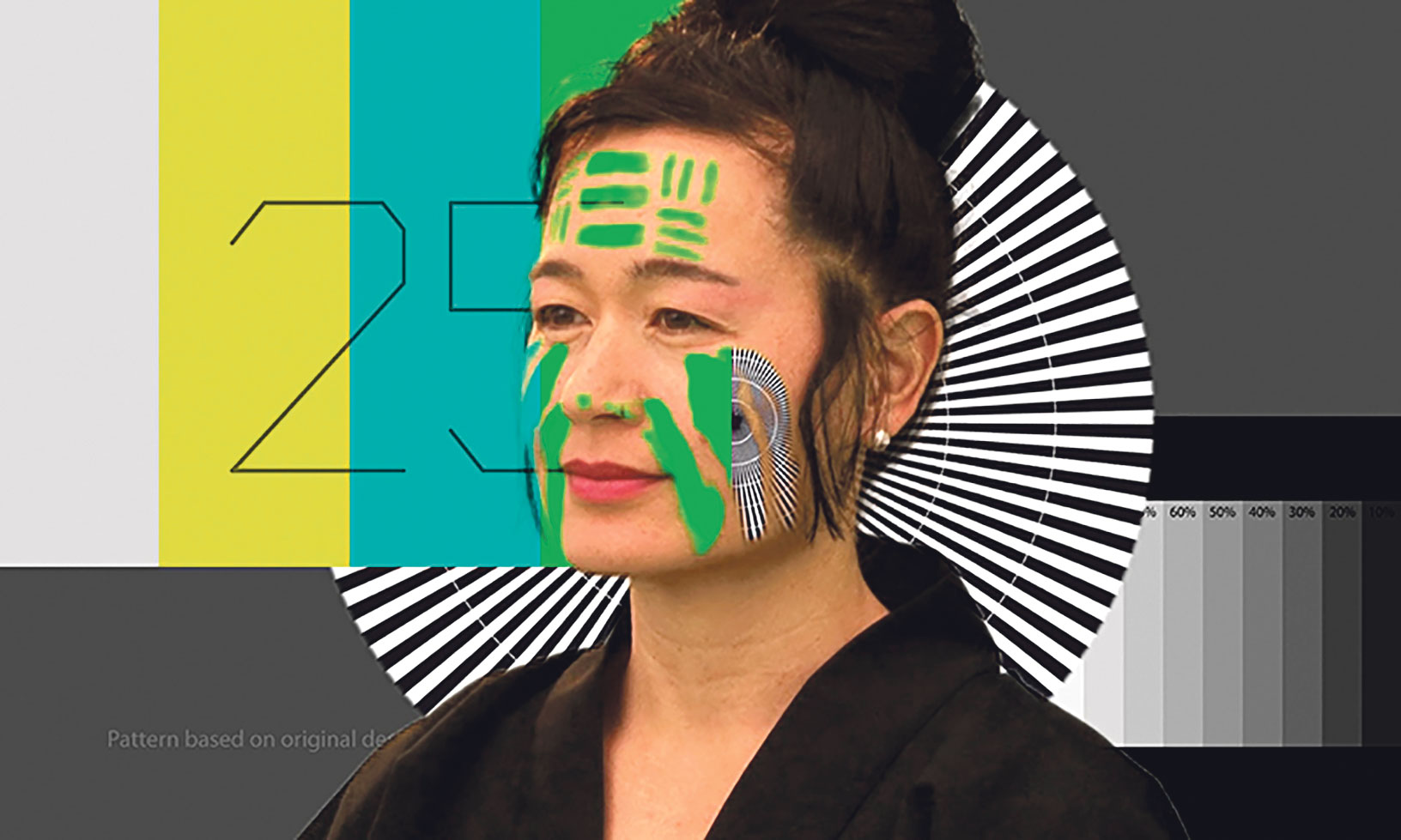
Hito Steyerl: Liquidity Inc.
HD video datoteka, jednokanalna u arhitektonskom okruženju, 30:15 min., 2014.
Ljubaznošću umjetnice, galerije Andrew Kreps, New York, i galerije Esther Schipper, Berlin
Liquidity Inc. is a multilayered portrait of Jacob Wood, a financial analyst who lost his job in the economic crash of 2008 and became a career mixed-martial-arts fighter. Wood’s story unfolds through real and virtual worlds that are made to overlap, combining conventions of documentary film with Internet syntax—hashtags, GIFs and memes. With its computer-generated waves and news footage of hurricanes and tsunamis, the work uses water and extreme weather as metaphors for the fluidity of financial assets and digital information, and for a collective sense of instability. The weather forecast is brought to us by The Weather Underground: “Tomorrow these trade winds begin working in reverse, blowing people back to their homes, blowing goods back to their factories, blowing factories back to their countries, blowing their countries back to their assumed origins.” Conflating terms from meteorology, geopolitics and digital culture, masked forecasters wryly suggest that weather patterns are determined by our own emotional states. You are invited to sit on the architectural structure, lined with judo mats, which the artist has compared to a raft wrecked by a raging storm. (MoMA/Inke Arns)
Hito Steyerl is a German filmmaker, moving image artist, writer, and innovator of the essay documentary. Her principal topics of interest are media, technology, and the global circulation of images. Steyerl holds a PhD in Philosophy from the Academy of Fine Arts Vienna. She is currently a professor of New Media Art at the Berlin University of the Arts, where she co-founded the Research Center for Proxy Politics, together with Vera Tollmann and Boaz Levin. She participated and has exhibited widely in solo and group shows: Chisenhale Gallery, London 2010; E-flux, New York, 2012; Artists Space, New York 2015; KOW, Berlin, 2015; Museo National Centro de Arte Reina Sofia, Madrid, 2015; Museum of Contemporary Art, Los Angeles, 2016, La Biennale di Venezia, 2019, Serpentine Galleries, London, 2019, and many more.